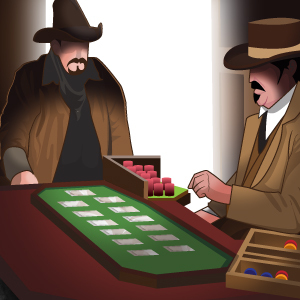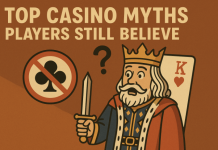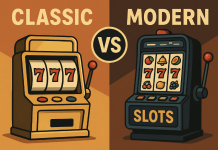Faro flourished in the casino houses of America and parts of Europe between the 1800 and 1900s. Now, it’s a long-lost pastime that remains firmly cemented in the obituaries of gambling history. You won’t find the game in any modern-day casino, nor are there many online versions available. But why exactly did this once-so-popular casino game lose its credibility, and why did Faro enthusiasts suddenly lose interest in playing?
Faro: In the Beginning
Faro was first established in 17th century southwest France. The game began as a spin-off of an older French card game known as Pharaon or “Pharaoh” as the French pronounced it. Pharaon led to another popular card game called Basset. However, King Louis XIV banned both games.
Even though the game was illegal in France at the time, it still circulated the underground gambling dens of Europe up until the 18th century. The Brits were one of the first nations to fully embrace the game, allured by its simplistic gameplay and easy-to-grasp rules. This was also when its name became shortened to the English alternative, Pharo. Soon it started to gain traction in regions like Prussia (pre Germany and Poland), as a simplified version, Deutsches Pharao, “German Pharao.”
Faro Hits America

At the turn of the 19th century, the game had reached the north west parts of the U.S. There it’s name changed yet again to the current and most-widely used spelling, “Faro.” The Americans also referred to the game as “bucking the tiger” or “twisting the tiger’s tail” due to the pictures of a Bengal tiger displayed on the old card packs. The tiger became so symbolic that casinos and gambling dens would hang a picture of a Bengal in the window to let players know they were hosting the game there.
By 1825, Faro was the most popular form of gambling in the Old West. It appeared in more than 150 gambling halls in Washington D.C. alone. In terms of how much money was wagered in the states each year, studies showed that Faro had outshone all other table games by the mid-19th century, including classics like roulette and blackjack. Despite the initial success, however, the hype around the game was short-lived.
The Cheating Conspiracy
Casinos thrived on the revenues and influx of visitors Faro attracted to their establishments. But the game also came under heavy criticism for being rife with scams, cheaters, and a rapid rise in gambling addiction. The worst of which was down to the casinos themselves. They often rigged the shoes in their own favor, removing chips, and stacking the decks.
Although the operators faced prosecution eventually, the game’s reputation suffered. Faro players were left with a bad taste in their mouths, and never truly knew if they were gambling a fair game. This led to a complete loss of interest by the time WWII broke out. The few places left to play the game at that point were gambling hot spots like Reno and Las Vegas.
Casinos Drop the Game
Somehow, Faro managed to survive another 50 or so years before disappearing from casino floors completely. Even though governing bodies monitored and regulated casinos, and despite it being near enough impossible to cheat on the game, the dawn of poker in casinos brought with it an insatiable demand for different card-playing games.
Traditional poker was already a well-established game and had been growing in popularity since it emerged in the 1800s. Once video poker machines appeared in casinos around the 1980s, however, this was pretty much the nail in the coffin for Faro. A few years later the game faded from the minds of gamblers completely.
How to Play Faro
Faro is a basic game that works with a standard 52-card deck. Players use chips to place their bets on one card of their choice. The objective is to draw a winning card of the same value. For example, if the player puts money on a queen, they are hoping that they will draw a queen to add to their collection. Players bet before each round, on one or several cards round.
The game starts with the dealer shuffling the deck, then placing all 52 cards into a shoe, also called a “dealing box.” The first card, known as the “soda card,” is removed from the deck first and discarded. The dealer then draws two additional cards — the first is for the banker and the second is for the player.
Bets placed on the banker card lose automatically. This means that if there was a bet on 4 for the banker’s card, for example, then the house wins all of the bets placed on this card. Any bets on the player’s hand automatically pay out at 1:1 if the winning card appears. This means if a player’s card is a 7, any wagers placed on this card will see an even payout.
You also have the option to wager on high cards as well. Meaning if the player’s card is higher than the value of the banker’s — you also win the bet. Outside bets remaining on the board carry on to the next round to place on the same card, a different card, or removed from the board altogether.
Conclusion
There’s been a few games that have seen instances of the house cheating players in the past. But no games will ever be quite as bitterly resented as Faro. This hasn’t stopped it from appearing in TV series like Deadwood, games like Assassin’s Creed, or echoed in different forms of pop culture today. However, it’s continuously regarded as a game of crooks, thugs, and murderous cheats.




